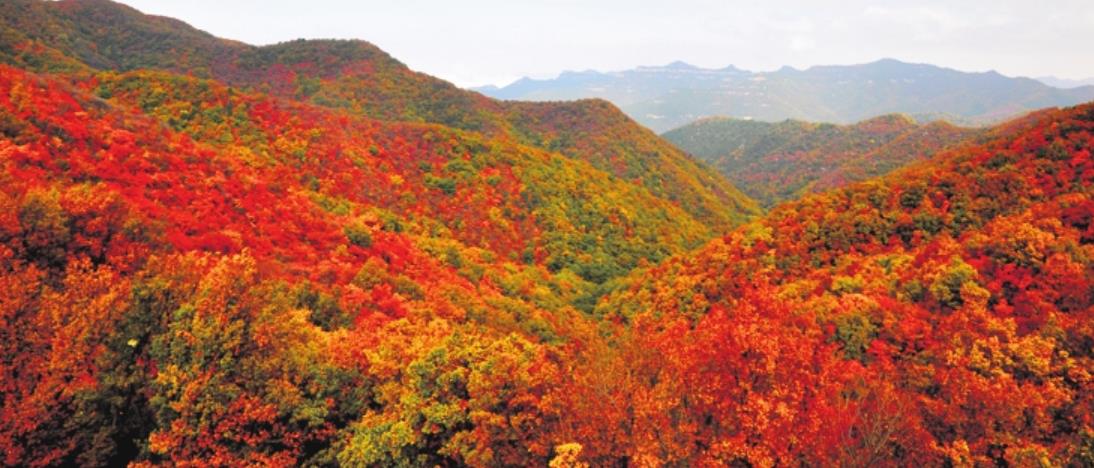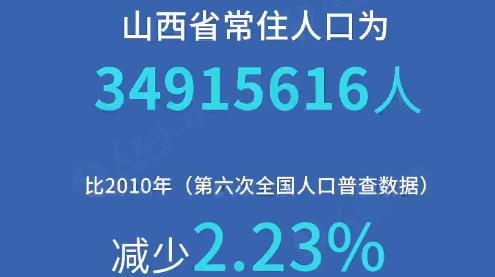
The historical Renzu Mountain offers a startling landscape when the leaves turn red in autumn. LYU GUIMING / FOR CHINA DAILY
When the Yellow River enters Jixian county in Shanxi province, it is embraced by a mountain and forms the most spectacular waterfall in its course of more than 5,400 kilometers.
Every year, millions of tourists visit the river and the renowned Hukou Waterfall.
The mountain, which is called Renzu, is a less popular site for tourists, who may not be aware that it has similar historical and cultural significance as the Yellow River.
Renzu, which literally means "ancestors of humans", was so named because locals believe the mountain provided a home for Fuxi and Nyuwa, the legendary ancestors of the Chinese people. Residents there have built temples to worship these figures.
The mountain's lesser-known legendary background was given a boost in 2001 with a major archaeological discovery.
In one of several sites that archaeologists explored, wall paintings with the images of Nyuwa were discovered.
Nyuwa is the mother goddess in Chinese mythology and is said to be the creator of human beings.
Also unearthed were stone tools pointing to a period between 100,000 and 80,000 years ago, a transitional period from the Old to the New Stone Age.
Geng Shiwen, a former boss of a local coal mine, said he has been enchanted by the mountain since the discovery.
In 2011, he signed an agreement with the county government, and invested almost all his wealth in developing the mountain into a tourist destination.
Renzu Mountain has an area of 203 square kilometers and the core area as a scenic spot covers about 45 sq km.
The scenic area includes a main peak that stands more than 1,700 meters above sea level and groups of ancient buildings.
The Nyuwa Temple is the major ancient structure complex in the scenic area. While the statue of Nyuwa sits in the main hall, the statue of Fuxi is in the side hall.
According Geng, Nyuwa and Fuxi are symbolically sister and brother and also wife and husband in Chinese mythology.
He reckoned that the temple was built in the Ming Dynasty (1368-1644), although there are not enough historical documents to support his judgment.
"I made the judgment according to the architectural styles and records of some preserved stone tablets," Geng said.
On every 18th day of the lunar calendar, there are grand ceremonies to pay tribute to Nyuwa and Fuxi, and the ceremony is currently a major cultural festival in the area, attracting tens of thousands of visitors, according to Geng.When the Yellow River enters Jixian county in Shanxi province, it is embraced by a mountain and forms the most spectacular waterfall in its course of more than 5,400 kilometers.
Every year, millions of tourists visit the river and the renowned Hukou Waterfall.
The mountain, which is called Renzu, is a less popular site for tourists, who may not be aware that it has similar historical and cultural significance as the Yellow River.
Renzu, which literally means "ancestors of humans", was so named because locals believe the mountain provided a home for Fuxi and Nyuwa, the legendary ancestors of the Chinese people. Residents there have built temples to worship these figures.
The mountain's lesser-known legendary background was given a boost in 2001 with a major archaeological discovery.
In one of several sites that archaeologists explored, wall paintings with the images of Nyuwa were discovered.
Nyuwa is the mother goddess in Chinese mythology and is said to be the creator of human beings.
Also unearthed were stone tools pointing to a period between 100,000 and 80,000 years ago, a transitional period from the Old to the New Stone Age.
Geng Shiwen, a former boss of a local coal mine, said he has been enchanted by the mountain since the discovery.
In 2011, he signed an agreement with the county government, and invested almost all his wealth in developing the mountain into a tourist destination.
Renzu Mountain has an area of 203 square kilometers and the core area as a scenic spot covers about 45 sq km.
The scenic area includes a main peak that stands more than 1,700 meters above sea level and groups of ancient buildings.
The Nyuwa Temple is the major ancient structure complex in the scenic area. While the statue of Nyuwa sits in the main hall, the statue of Fuxi is in the side hall.
According Geng, Nyuwa and Fuxi are symbolically sister and brother and also wife and husband in Chinese mythology.
He reckoned that the temple was built in the Ming Dynasty (1368-1644), although there are not enough historical documents to support his judgment.
"I made the judgment according to the architectural styles and records of some preserved stone tablets," Geng said.
On every 18th day of the lunar calendar, there are grand ceremonies to pay tribute to Nyuwa and Fuxi, and the ceremony is currently a major cultural festival in the area, attracting tens of thousands of visitors, according to Geng.
"I made the judgment according to the architectural styles and records of some preserved stone tablets," Geng said.
On every 18th day of the lunar calendar, there are grand ceremonies to pay tribute to Nyuwa and Fuxi, and the ceremony is currently a major cultural festival in the area, attracting tens of thousands of visitors, according to Geng.
Li Yali contributed to this story.
By YUAN SHENGGAO
 山西路橋:黨建引領 建好“四好農村路”山西路橋建設集團黨委扎實開展“黨建質量提升年”,實施“六大工程”,立足“十四五”高質量、高速度、高效益發展的戰略基點,全面提高黨建質量和黨建引領發展水平,為打造“國內一流的交通基礎設施投資、建設、施工現代化企業集團”提供堅強政治保障。
山西路橋:黨建引領 建好“四好農村路”山西路橋建設集團黨委扎實開展“黨建質量提升年”,實施“六大工程”,立足“十四五”高質量、高速度、高效益發展的戰略基點,全面提高黨建質量和黨建引領發展水平,為打造“國內一流的交通基礎設施投資、建設、施工現代化企業集團”提供堅強政治保障。
 常住人口3491萬 山西人口普查數據"出爐"山西省統計局向社會通報山西省第七次全國人口普查主要數據。數據顯示,山西省常住人口為34915616人,比2010年(第六次全國人口普查數據,下同)減少2.23%,年平均減少0.23%。山西省常住人口總量減少,主要受人口流動變化等因素影響。
常住人口3491萬 山西人口普查數據"出爐"山西省統計局向社會通報山西省第七次全國人口普查主要數據。數據顯示,山西省常住人口為34915616人,比2010年(第六次全國人口普查數據,下同)減少2.23%,年平均減少0.23%。山西省常住人口總量減少,主要受人口流動變化等因素影響。